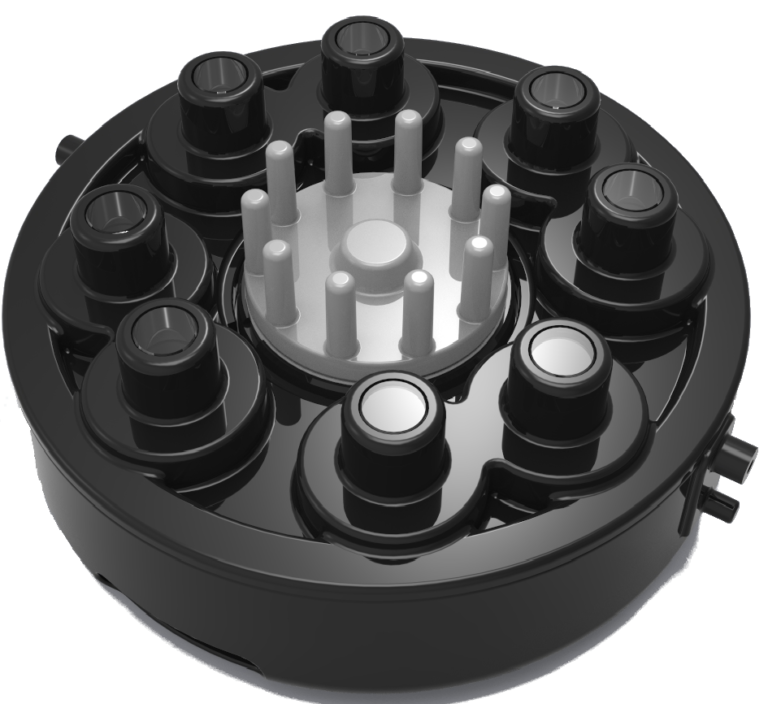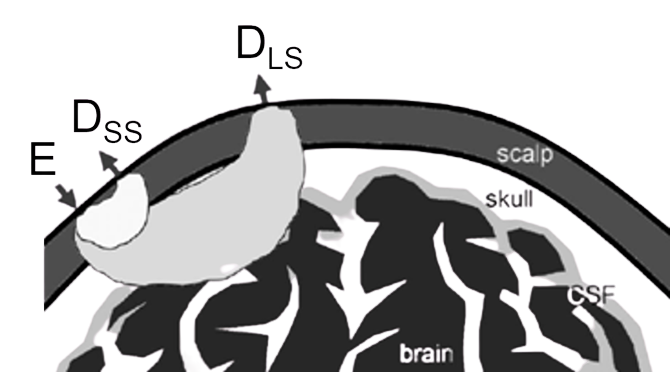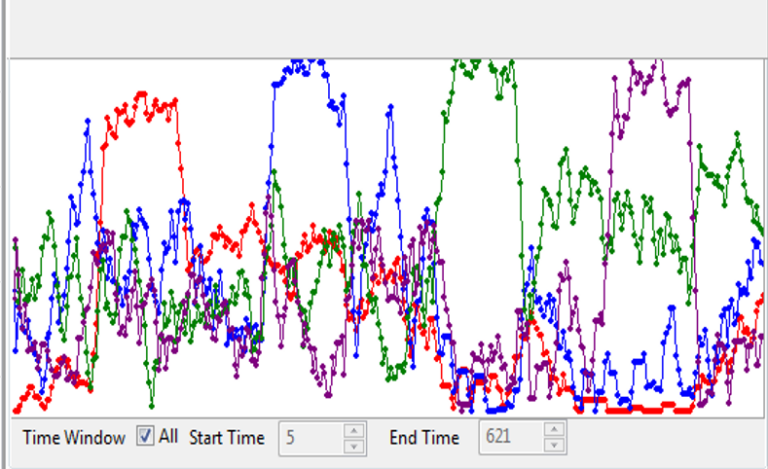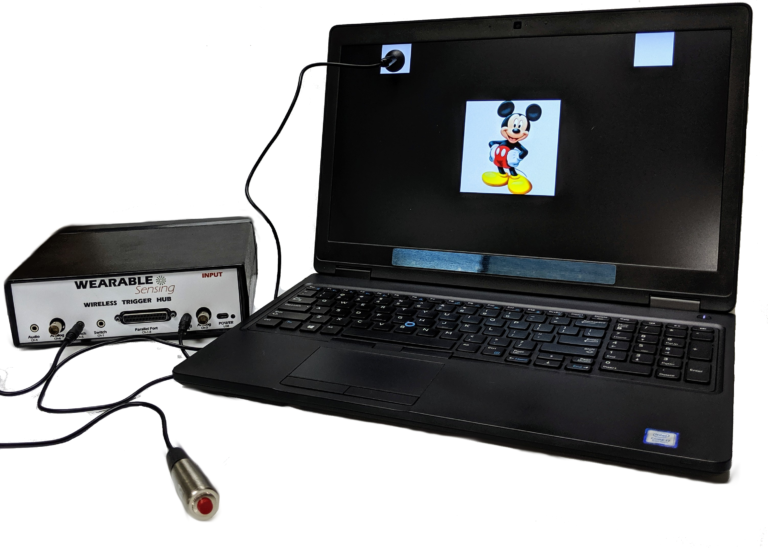Wearable Sensing’s wireless DSI-EEG+fNIRS system is the first truly hybrid system, enabling simultaneous, automatically synchronized recordings of dry EEG and fNIRS from the same location. The system is built with Wearable Sensing’s leading dry electrodes in terms of signal quality and comfort, and Archinoetics ultra-bright LED’s integrated into the emitters. The DSI-EEG+fNIRS takes on average less than 3 minutes to set up, making it the ideal solution for scientists in need of a simple, easy to use, EEG system. Our patented sensor technology not only delivers uncompromised signal quality but also enables our system to be virtually immune against motion and electrical artifacts.
The DSI-EEG+fNIRS has 8 pods, each with 4 emitters and 4 detectors, and a dry electrode EEG sensor in the middle. There are 2 pods on the pre-frontal cortex, 2 pods on the temporal lobe, 2 pods on the motor cortex, and 2 pods on the occipital lobe. This sensor configuration allows scientists to do a variety of different experiments, including mental workload tasks, auditory tasks, motor tasks, and visual tasks.
Used around the world by leaders in Research, & Brain-Computer Interfaces

The DSI EEG+fNIRS system is the first true hybrid system on the market, enabling colocalized recordings of the two modalities, designed for various neurovascular coupling research. There are a total of 8 sensor pods on the system, and each pod has 1 EEG sensor in the middle, 4 emitters, and 4 detectors surrounding. All of the data is digitized together, and thus, synchronized automatically

Mayer wave is a systemic oscilliation in the blood throughout the whole body, that causing a slow frequency artifact in fNIRS. The configuration of the emitters and detectors on each pod allows us to record short distance and long distance paths. The short distance path allows us record only the Mayer wave, while long distance gives us Mayer wavbe and fNIRS. Using linear regression, we can automatically remove this artifact from the data

Using QStates, we were able to differentiate the selectivity of the pod locations based on specific tasks. We trained 4 models to classify whether the subject was doing a visual (red), auditory (blue), cognitive (green), or psychomotor task (purple). Then, we ran a single trial where the subject started by doing each type of task individually, and we were able to clearly classify the cognitive state based on the task at hand

Wearable Sensing has partnered with Archinoetics to integrate their extremely powerful LEDs into the emitters. In the figure shown above, you can see how our emitters (red line) are brighter, and turn on and off faster than traditional fNIRS emitters (black line). This will allow the detector to have more time to detect activity, and thus create a stronger and more robust fNIRS signal. We also have a custom silicon photodiode with gain, amplified directly at the source.
With over 90% correlation to research-grade wet EEG systems, the dry sensor interface (DSI) offers unparalleled quality and performance
Multiple adjustment points and a foam pad lined interior enable the system to be worn for up to 8 hours on any head shape or size
All DSI systems include free, unlimited licenses of DSI-Streamer, our data acquisition software which can record raw data, in .csv and .edf file formats
Faraday cage's, spring-loaded electrodes, and our patented common-mode follower technology, provides near immunity against electrical and motion artifacts
Using 70% isopropyl alcohol and a cleaning brush, the DSI-EEG+fNIR only takes a minute to clean, 3 minutes to dry, and can be up and running on the next subject in minutes
All DSI systems include our free C based .dll API, which enables users to pull the raw data directly from the headset, for custom software on Windows, Mac OS, Linux, and ARM
The DSI-EEG+fNIRS was designed for ultra-rapid setup, taking on average less than 3 minutes to don. Software automatically tunes fNIRS for most optimal path
DSI headsets have active sensors, amplifiers, digitizers, batteries, onboard storage, and wireless transmission, making them complete, mobile, wearable EEG systems
DSI systems exclusively work with QStates, a machine learning algorithm for cognitive classification on states such as mental workload, engagement, and fatigue

Our Wireless Trigger Hub simplifies the synchronization of DSI headsets with other devices. It features:
An additional benefit of the Trigger Hub design is that it allows synchronization across multiple data sources that are distributed across multiple systems, each of which running at its own clock rate. One such case commonly experienced in EEG experiments involves the synchronization of EEG and eye-tracking measurements, where the inevitable clock drift that arises between two systems during extended measurements creates difficulty in aligning data to events across the two systems.
The DSI-24 has 3 auxiliary inputs on the headset, which allows for automatic synchronization of Wearable Sensing’s auxiliary sensors to the EEG. The sensors available include ECG, EMG, EOG, GSR, RESP, & TEMP. The sensor data is collected and recorded in our data acquisition software, DSI-Streamer, where you can view the EEG and Aux sensors in real-time.
EEG Channels
Fp1, Fp2, C3, C4, T3, T4, O1, O2, A1, A2
Reference / Ground
Common Mode Follower (Pz) / Fpz
Head Size Range
52cm – 62cm circumference
Sampling Rate
300 Hz (600Hz upgrade available) EEG
15 Hz fNIR
Bandwidth
0.003 – 150 Hz EEG
40 nm fNIR
fNIR POD
4 Emitters and 4 Detectors
fNIR Emitters
4 LED (Class I Laser) per sensor
Emitter Frequencies
760, 808, 850 nm
fNIR Detectors
SiPD with integrated Gain
Detector Sensitivity
0.13 pW
Wireless
Bluetooth
Wireless Range
10 m
Run Time
4 hours
Data Acquisition
Real time, evoked potentials
Signal Quality Monitoring
Continuous impedance, Baseline offset, Noise (1-50 Hz)
Data Type
Raw and Filtered Data available
File Type
.CSV and .EDF
Data Output Streaming
TCP/IP socket, API (C Based), LSL
Cognitive State Classification
Brain Computer Interface
SSVEP BCI Algorithms; BCI2000; OpenViBE; PsychoPy; BCILab
Data Integration / Analysis
CAPTIV; Lab Streaming Layer; NeuroPype; BrainStorm; NeuroVIS
Neurofeedback
Applied Neuroscience NeuroGuide; Brainmaster Brain Avatar; EEGer
Neuromarketing
CAPTIV Neurolab
Presentation
Presentation; E-Prime
Please fill out the form and provide a brief description of your application so we can help match you with products that will meet your specific needs.
Please fill out the form and provide a brief description of your application so we can help match you with products that will meet your specific needs.
